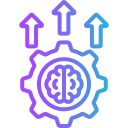As the world shifts toward sustainable energy solutions, artificial intelligence is rapidly emerging as a foundational technology driving innovation in renewable energy systems. AI’s ability to learn from vast datasets, predict outcomes, and automate complex processes is proving invaluable in maximizing efficiency, reducing costs, and accelerating the global transition to clean energy. This page explores how AI is revolutionizing renewable energy, from optimizing energy production to transforming grid management and empowering smarter consumption.
Enhancing Energy Generation with AI
AI-driven analytics are redefining the maintenance and output of solar panel installations. By continuously analyzing data from sensors and historical performance logs, algorithms can detect anomalies or inefficiencies in individual panels. Predictive models alert operators before any significant drop in output occurs, enabling timely cleaning, repairs, or adjustments. This proactive approach minimizes downtime and sustains peak energy production, making solar farms more profitable and resilient against variable weather conditions. Over time, the system also “learns” the unique characteristics of each installation, fine-tuning its recommendations to maximize long-term performance and return on investment.
Adaptive Battery Management Systems
AI enhances battery energy storage systems (BESS) by dynamically managing charge and discharge cycles based on real-time grid conditions and demand forecasts. Predictive analytics anticipate periods of surplus and shortfall, enabling batteries to absorb excess energy when generation spikes and release it when demand rises. Over time, the system optimizes these cycles to minimize wear and extend battery lifespan. This intelligent approach supports grid stability, reduces waste, and ensures a more reliable renewable energy supply, even during periods of low wind or sunlight.
Dynamic Grid Balancing
The integration of variable renewables requires a fundamentally different approach to grid management. AI-driven control systems act as the “brain” of modern grids, instantly responding to fluctuations in power generation and consumption. By continuously analyzing data from interconnected sources, these platforms can automatically balance loads, reroute electricity, and stabilize voltage levels. Their sophisticated modeling allows for seamless integration of distributed energy resources, minimizing blackouts and making it possible to operate with far greater shares of wind and solar than previously thought feasible.
Predictive Energy Demand Forecasting
Effective renewable integration hinges on accurate forecasts of energy consumption patterns. AI excels at modeling complex, ever-changing demand—incorporating factors like weather, grid activity, and social behavior. By providing granular, forward-looking insights, these models empower utilities and grid operators to orchestrate supply, optimize storage, and avoid costly last-minute purchases from less sustainable sources. Over time, these forecasts enable more efficient planning and better utilization of renewables, ultimately reducing dependence on fossil fuels and enhancing energy security.
Previous slide
Next slide

Accelerating Renewable Project Development
01
Site Selection and Resource Assessment
Choosing an optimal location is crucial for the success of renewable energy projects. AI systems analyze geospatial data, weather patterns, topography, and proximity to existing infrastructure to recommend the best sites for wind, solar, or hydro installations. These advanced analyses provide a level of precision unattainable through traditional methods, factoring in long-term climate trends and land use constraints. In doing so, AI helps developers minimize risk, secure optimal yields, and make more informed investment decisions before breaking ground.
02
Project Design and Simulation
Designing renewable energy systems is an intricate task that involves balancing technical, environmental, and economic factors. AI-powered design tools rapidly generate and evaluate multiple project configurations, simulating their performance under varying conditions. This enables engineers to identify designs that maximize both efficiency and profitability while ensuring regulatory compliance. By automating much of the trial-and-error process, AI accelerates decision-making, reduces upfront engineering costs, and leads to more innovative and effective renewable projects.
03
Construction Planning and Risk Management
The construction phase of renewable energy projects is fraught with uncertainties—from shifting supply chains to unpredictable weather events. AI-based risk management systems analyze data from previous projects, weather forecasts, and global logistics to identify potential bottlenecks and suggest mitigation strategies. These platforms also optimize construction schedules and resource allocation to keep projects on time and within budget. The result is faster project delivery, fewer costly delays, and a stronger foundation for long-term operational success.
Join our mailing list
